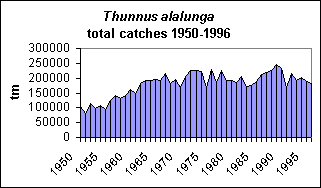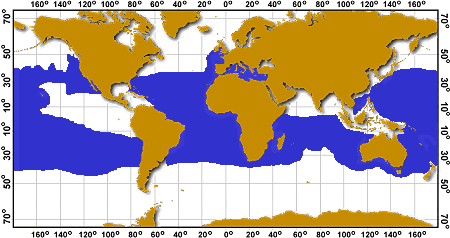
|
FAO Names |
En - Albacore; Fr - Germon; Sp - Atn blanco. | |||
Size |
|
|||
| Diagnostic Features |  A large species,
deepest at a more posterior point than in other tunas
(at, or only slightly anterior to, second dorsal fin
rather than near middle of first dorsal fin base).
Gillrakers 25 to 31 on first arch. Second dorsal fin
clearly lower than first dorsal; pectoral fins remarkably
long, usually 30% of fork length or longer in 50 cm or
longer fish, reaching well beyond origin of second dorsal
fin (usually up to second dorsal finlet). Fish smaller
than 50 cm will have proportionately smaller pectorals
than other tunas, i.e. T. obesus. Ventral surface of
liver striated (vascular network). Swim bladder present,
but poorly developed and not evident in fish smaller than
about 50 cm fork length. Vertebrae 18 precaudal plus 21
caudal. Colour: a faint lateral iridescent blue band runs
along sides in live fish; first dorsal fin deep yellow,
second dorsal and anal fins light yellow, anal finlets
dark; posterior margin of caudal fin white. A large species,
deepest at a more posterior point than in other tunas
(at, or only slightly anterior to, second dorsal fin
rather than near middle of first dorsal fin base).
Gillrakers 25 to 31 on first arch. Second dorsal fin
clearly lower than first dorsal; pectoral fins remarkably
long, usually 30% of fork length or longer in 50 cm or
longer fish, reaching well beyond origin of second dorsal
fin (usually up to second dorsal finlet). Fish smaller
than 50 cm will have proportionately smaller pectorals
than other tunas, i.e. T. obesus. Ventral surface of
liver striated (vascular network). Swim bladder present,
but poorly developed and not evident in fish smaller than
about 50 cm fork length. Vertebrae 18 precaudal plus 21
caudal. Colour: a faint lateral iridescent blue band runs
along sides in live fish; first dorsal fin deep yellow,
second dorsal and anal fins light yellow, anal finlets
dark; posterior margin of caudal fin white. |
|||
| Geographical Distribution |  Cosmopolitan in
tropical and temperate waters of all oceans including the
Mediterranean Sea extending north to 45 to 50? N and
south to 30 to 40 S, but not at the surface between 10 N
and 10 S. Cosmopolitan in
tropical and temperate waters of all oceans including the
Mediterranean Sea extending north to 45 to 50? N and
south to 30 to 40 S, but not at the surface between 10 N
and 10 S. |
|||